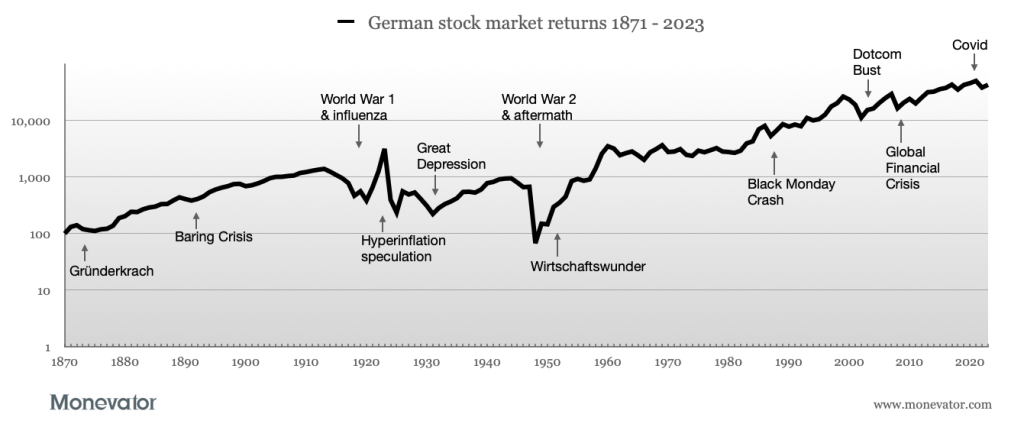
Orthodox investing advice has always been that UK investors should hold either gilts or high-quality global government bonds hedged to UK pounds (GBP) for the main part of their defensive asset allocation.
I’ve long subscribed to that advice myself.
Highly-rated government bonds provide the defensive ballast for your investing strategy. Sticking with your local currency – in our case GBP – avoids adding additional riskiness into what’s meant to be the steadier portion of our portfolio.
But (heresy alert!) recent evidence suggests that unhedged US Treasuries could be a better choice.
Why? Because the dollar has risen against the pound in the majority of stock market slumps since the turn of the century. When it did so, it bestowed a welcome FX bonus for UK-based investors who owned US government bonds – juicing up their defensive returns at just the right time.
The upshot is holding US bonds can protect your portfolio from equity losses better than home-grown gilts – when it works.
But what if that trend is a reversible historical anomaly, and not a bankable portfolio hack?
To approach that question we need to ask some others.
For starters, did US Treasuries dominate gilts for more than just the past couple of decades?
A second salient question: how does this strategy impact long-term returns? Because if US bonds actually deliver lower returns than gilts over time then they become much less attractive, even if they do better for a bit in a crunch.
Maybe those currency gains quickly unwind once market jitters subside, exposing UK passive investors to FX blowback and potentially extra-nasty losses if they’re caught sitting in US Treasuries?
It’s quite the conundrum. But if I’m better off holding US Treasuries instead of gilts though then I’d really like to know about it. So let’s dive in.
UK vs USA: enter at your own risk
Before getting to the good bit, we need to repeat that holding unhedged US Treasuries ahead of UK gilts means adding currency risk to your fixed income asset allocation.
Currency risk can work for you or against you:
A UK investor – with assets valued in US dollars (USD) – benefits when the pound weakens against the dollar. A rising dollar means USD-priced assets are now more valuable in GBP terms.
Equally, USD assets sink in value in GBP terms when sterling strengthens. The dollar price of such US assets is now worth less in pounds.
These gains or losses from currency risk are grafted on top of the asset’s underlying return.
If you invest in unhedged US Treasuries, you’re hoping for two things to happen:
Your government bonds spike as global equities tumble.
You additionally profit from the surge in demand for dollar-priced assets.
Hence this ploy adds an extra risk to your collection. Namely, that the dollar doesn’t live up to its reputation as a safe-haven during a market tailspin.
If the USD falls against the pound in an “adopt the brace position!” scenario then the currency knock-back could swamp any bond bounce you hoped to gain.
All of which tells us that playing FX roulette with your defensive allocation is like releasing a predator into the environment to wipe out a pest species.
It’s inherently risky and it may not work as advertised.
UK vs USA: battle of the government bonds
To discover how frequently US Treasuries beat gilts during sustained stock market falls, I calculated the annual total returns of unhedged US Treasuries in GBP from 1971 to 2022.
We’re looking at GBP returns throughout because we’re interested in this substitution from the perspective of a UK investor.
And those dates were selected because they span the entire floating exchange rate era for currencies, up until this year.
Next I compared the GBP returns of Treasury Bonds against gilts in every year when UK equities registered a negative annual return and/or the UK stock market fell 10% or more, for a period of at least one month, regardless of whether that loss is revealed by the annual returns data.
Against that backdrop, US Treasuries beat gilts in 15 years out of a sample of 21:
Nominal total return data from JST Macrohistory1, FTSE Russell, and Aswath Damodaran. Annual exchange rate from Measuring Worth2. February 2023.
Gosh, that’s quite the thumping. Not as bad as our record in the America’s Cup, but still a comprehensive win for US Treasuries.
Is that it in then? Is it time to ditch our gilts? Do we never need to worry about a mad Prime Minister ever again?
Not so fast…
US Treasuries vs gilts: overall annualised returns
Next I looked at the match-up between gilts and US Treasuries over the entire period, in terms of their annualised returns.
And oh my, the plucky Brits have won something!
George Washington, John Bogle, Beyonce, are you watching? Your bonds took a helluva beating! Okay, sorry about that – I may have got carried away and slightly exaggerated.
The bond scores are:
8.3% gilts
8.0% US Treasury bonds
Those are nominal, average annualised returns across the entire 52-year period, for an investor operating in UK pounds.
And there’s essentially nothing in it. Regardless of whether you bought and held gilts or Treasuries, your overall returns were much the same after 52 years.
US government bonds actually bested gilts, by 28 years to 24. But much of the gain made in US Treasuries during down periods was later undone by the strengthening pound when market confidence was restored.
US Treasury Bonds vs gilts: across the decades
Next question: are there distinct eras when owning US Treasuries worked best for UK investors?
The table below shows how many years per decade that US government bond returns exceeded gilts when UK equities fell (same criteria as before):
Decade
US Treasuries
UK gilts
1970s
4
1
1980s
1
1
1990s
1
3
2000s
4
0
2010s
3
1
2020s
2
0
By this reckoning, the 1990s was the only decade when US Treasuries didn’t counterbalance sliding stock prices at least as well as gilts.
However even this data hides decent periods for our boys versus US Treasuries.
Most notably, gilts made a comeback versus US Treasuries in the late 1970s, held their own in the 1980s, and then actually outperformed in the 1990s during those down years.
So preferring US bonds didn’t benefit UK investors for about a quarter of a century.
How bad are US Treasuries when they don’t perform?
When equities caved but gilts outperformed Treasuries, the average nominal annual return for each government bond for UK holders was:
US Treasuries: -2.3%
Gilts: 12.3%
Which is a painful showing for the US asset – one that would probably leave you ruing the decision to go off-piste if it happened to your portfolio.
As mentioned at the start, the problem with adding a currency play to the bond side of your portfolio is that FX volatility can swamp the asset’s typically more modest underlying returns.
Hence my biggest fear with this strategy is that an adverse currency move could cause US bonds to inflict large negative returns upon investors who are already buckling under the strain of watching their equities nosedive.
The worst GBP annual return for Treasury bonds was -13.2% during 1987 – the same year as the Black Monday Crash. In contrast gilts were up 17.9% that year.
That said, when gilts fell -16% in 1974 and -24% in 2022, US Treasuries were up 7% and down only -9%, respectively.
America the Beautiful
How do things look when US Treasuries beat gilts during stock market losing streaks?
Well, under these conditions, average nominal annual returns for the two government bond types were:
US Treasuries: 12.3%
Gilts: 2.3%
Meanwhile, across all 21 of the down years we looked at earlier, the average annual returns gap narrows to:
US Treasuries: 8.1%
Gilts: 5.2%
It’s still advantage US Treasuries, but the picture is more mixed.
Which leads me to wonder: which bond is the better option during a proper nightmare?
Which bond works best during the worst bear markets
The stiffest tests of investor nerve this past half century were the 1972-74 stock market crash, the Dotcom Bust, and the Global Financial Crisis.
US Treasuries beat gilts 3-0 during these utter meltdowns.
Here are the average returns:
US Treasuries: 13.2%
Gilts: 1.5%
That’s a big performance gap. US bonds potentially bucked up your portfolio just when you needed it most.
However, there’s one final and important check we need to make.
What difference does replacing UK government bonds with US Treasuries make to the overall returns for a globally diversified portfolio?
US Treasuries vs gilts: diversified portfolio returns
I compared the long-term results of two diversified portfolios. Both feature 60% MSCI World equities, with the remaining 40% devoted to either gilts or US Treasury Bonds.
And it’s a photo-finish!
Here are the nominal, annualised returns for the two portfolios (1971-2022):
World / US Treasuries: 9.88% annualised
World / Gilts: 9.94% annualised
(Equity returns are in GBP from the MSCI World index. Portfolios rebalanced annually.)
However, it wasn’t so close over the entire time frame. The portfolio with gilts was actually an annual percentage point ahead by the end of the 1990s.
It was still almost half a percentage point ahead before the Brexit Referendum.
US Treasuries vs gilts: bet now!
We’ve seen then that US Treasuries can indeed cushion your portfolio better than gilts when equity confidence crumbles. Not all of the time, but the majority of the time, at least historically. And especially in the worst crunches.
However just to keep things interesting, gilts edged the win when it comes to overall portfolio returns.
To me this strongly suggests the strategy is only worth considering if you’re a particular type of investor – one who is hands-on with your portfolio, enjoys managing extra complexity, and understands the extra currency risk may not pay off (and might even backfire) at the worst possible time.
So if you want to keep things simple, then you can happily leave this ploy alone.
Despite 50 years of relative UK economic decline, you’d still have been better off owning gilts all told.
Cool Britannia revisited
Don’t fall for gloomy geopolitical narratives that the UK is destined for the international knacker’s yard.
Plausible-sounding storylines of doom are the stock-in-trade of financial punditry. But they’re no basis for a long-term investing strategy.
To give you but one counterpoint: nobody would have predicted gilts would buck the trend against US Treasuries after Britain lurched from crisis to crisis during the 1970s as ‘the sick man of Europe’.
Sure, we’re in a mess right now. But our current national conversation could as easily signal a turning point as herald further decline.
Finally, if you are tempted by the idea of adding unhedged US Treasuries then consider dipping a toe in the water, rather than entirely ditching gilts (or GBP hedged global bonds).
You could split your nominal bond allocation fifty-fifty, for example. Or you could instead buy a slug of gold, given it’s a non-correlated defensive asset that also boosts UK investors when the dollar rises.
Take it steady,
The Accumulator
Òscar Jordà, Katharina Knoll, Dmitry Kuvshinov, Moritz Schularick, and Alan M. Taylor. 2019. “The Rate of Return on Everything, 1870–2015.” Quarterly Journal of Economics, 134(3), 1225-1298.Lawrence H. Officer, “Dollar-Pound Exchange Rate From 1791,” MeasuringWorth, 2023.
The post Are US Treasuries better than gilts for UK investors? appeared first on Monevator.



